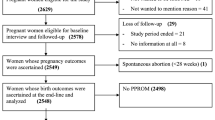Abstract
Objective
The objective of the study was to assess the factors affecting the latency period in woman with preterm premature rupture of membranes (PPROM) and evaluate morbidity associated with prolonged latency.
Study design
A population-based retrospective study including all women with PPROM (prior to 37 weeks’ gestation) during the years 1998–2008 was conducted. Comparison of the latency period was conducted by the Mann–Whitney U test since the latency period was not normally distributed (most delivered in 24 h). Multivariable logistic regression model was constructed to find independent factors associated with prolonged latency period (>72 h).
Results
During the study period, there were 1,399 singleton deliveries of patients with PPROM; 24.6% (345) occurred prior to 34 weeks’ gestation. The duration of the latency period was significantly longer among woman with PPROM before 34 weeks as compared to PPROM after 34 weeks’ gestation (5.78 vs. 2.02 days; p < 0.001). Other factors associated with longer latency period were multiparity (more than one previous delivery) and maternal age >35. Using a multivariable analysis, the following factors were significantly associated with latency period >72 h: lower gestational age (weeks, OR = 0.8, 95% CI 0.77–0.84; p < 0.001) and multiparity (OR = 1.7, 95% CI 1.3–2.2; p < 0.001). Prolonged latency period (>72 h) was significantly associated with chorioamnionitis (OR = 2.095, 95% CI 1.44–3.04; p < 0.001) and oligohydramnios (OR = 3.041, 95% CI 1.43–6.45; p = 0.004) but not with placental abruption (OR = 0.854, 95% CI 0.41–1.78; p = 0.674) or perinatal mortality (OR = 1.2, 95% CI 0.6–2.2; p = 0.556).
Conclusion
The duration of the latency period is inversely associated with gestational age. Nulliparity is associated with lower latency period. Prolonged latency is a significant risk factor for chorioamnionitis.

Similar content being viewed by others
References
Caughey AB, Robinson JN, Norwitz ER (2008) Contemporary diagnosis and management of preterm premature rupture of membranes. Rev Obstet Gynecol 1:11–22
ACOG Committee on Practice Bulletins-Obstetrics (2007) Premature rupture of membranes. Clinical management guidelines for obstetrician-gynecologists, ACOG Practice Bulletin No. 80. Obstet Gynecol 109:1007–1019
Mercer BM, Goldenberg RL, Meis PJ, Moawad AH, Shellhaas C, Das A, Menard MK, Caritis SN, Thurnau GR, Dombrowski MP, Miodovnik M, Roberts JM, McNellis D (2000) The Preterm Prediction Study: prediction of preterm premature rupture of membranes through clinical findings and ancillary testing. The National Institute of Child Health and Human Development Maternal-Fetal Medicine Units Network. Am J Obstet Gynecol 183:738–745
Hannah ME, Ohlsson A, Farine D, Hewson SA, Hodnett ED, Myhr TL, Wang EE, Weston JA, Willan AR (1996) Induction of labor compared with expectant management for prelabor rupture of the membranes at term. TERM PROM Study Group. N Engl J Med 334:1005–1010
Newman DE, Paamoni-Keren O, Press F, Wiznitzer A, Mazor M, Sheiner E (2009) Neonatal outcome in preterm deliveries between 23 and 27 weeks’ gestation with and without preterm premature rupture of membranes. Arch Gynecol Obstet 280(1):7–11
Sheiner E, Shoham-Vardi I, Hadar A, Hallak M, Hackmon R, Mazor M (2002) Incidence, obstetric risk factors and pregnancy outcome of preterm placental abruption: retrospective analysis. J Matern Fetal Neonatal Med 11:34–39
Aziz N, Cheng YW, Caughey AB (2008) Factors and outcomes associated with longer latency in premature rupture of membranes. J Matern Fetal Neonatal Med 21:821–825
Medina TM, Hill DA (2006) Preterm premature rupture of membranes: diagnosis and management. Am Fam Phys 73:659–664
Mathews TJ, Curtin SC, MacDorman MF (2000) Infant mortality statistics from the 1998 period linked birth/infant death data set. Natl Vital Stat Rep 48:1–25
Fonseca EB, Celik E, Parra M, Singh M, Nicolaides KH (2007) Progesterone and the risk of preterm birth among women with a short cervix. N Engl J Med 357:462–469
Melamed N, Hadar E, Ben-Haroush A, Kaplan B, Yogev Y (2009) Factors affecting the duration of the latency period in preterm premature rupture of membranes. J Matern Fetal Neonatal Med 22(11):1051–1056
Hnat MD, Mercer BM, Thurnau G et al (2005) Perinatal outcomes in women with preterm rupture of membranes between 24 and 32 weeks of gestation and a history of vaginal bleeding. Am J Obstet Gynecol 193(1):164–168
Nelson LH, Anderson RL, O’Shea TM, Swain M (1994) Expectant management of preterm premature rupture of the membranes. Am J Obstet Gynecol 171(2):350–356 (discussion 356–358)
Park JS, Yoon BH, Romero R, Moon JB, Oh SY, Kim JC, Jun JK (2001) The relationship between oligohydramnios and the onset of preterm labor in preterm premature rupture of membranes. Am J Obstet Gynecol 184(3):459–462
Conflict of interest statement
None.
Author information
Authors and Affiliations
Corresponding author
Additional information
Performed in part of Gidon Test MD requirements.
Rights and permissions
About this article
Cite this article
Test, G., Levy, A., Wiznitzer, A. et al. Factors affecting the latency period in patients with preterm premature rupture of membranes. Arch Gynecol Obstet 283, 707–710 (2011). https://doi.org/10.1007/s00404-010-1448-7
Received:
Accepted:
Published:
Issue Date:
DOI: https://doi.org/10.1007/s00404-010-1448-7




